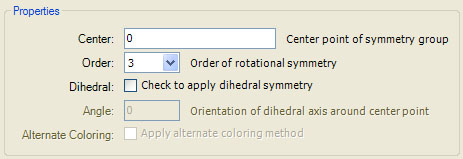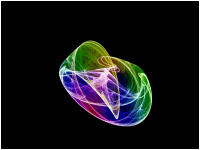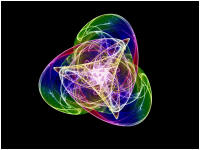
In Part 5 of the tutorial, we are going to generate an image based on the built-in Orbital Equation Cubic Attractors and then add 3-way symmetry to the image.
First, we are going to change the controller used to process the image.
Select the Gradient Map - Value properties page:
General
Orbital / IFS / Strange
Attractor
Controllers
Gradient Map - Value
This page is a Program Editor for an Orbital Controller.
Set Based On to Direct Color Map - RGB Blend.

Select the program's properties page:
General
Orbital / IFS / Strange
Attractor
Controllers
Direct Color
Map - RGB Blend
Properties
This controller constructs 2 colors using sample data values as the RGB components and then blends the colors using a color blending function. The mapping of the sample data to the RGB components and the color blending function are controlled via program's properties. It is impossible to predict what you will get using this controller and by changing the controller's properties, you can get wildly different results. Normally, you would set up the rest of the fractal and then play around with these properties until you get a result you like. For the sake of simplicity we are going to accept the default values in this tutorial.
Go back to the Program Editor for the Orbital Equation:
General
Orbital / IFS / Strange
Attractor
Symmetric Icon - Standard Formula
Set Based On to Cubic Attractors.

This equation is based on one of the formulas given in J. C. Sprott's book Strange Attractors: Creating Patterns in Chaos.
Read the comments in the program's Instructions at the bottom of the page and then select the program's Properties page and set Attractor to MWJCHFBXMHJXEGWUEBUU.
![]()
You can give the combobox focus by clicking on it and then type the first letter of the item you want to find (M in this case) until you find the item you need. Each time you type the letter, the next item starting with that letter is displayed. This seemingly random sequence of letters corresponds to the coefficients of the formula used to produce the attractor.
Execute the Display Fractal command on the Tools menu of the Fractal Window to generate the fractal image.
Now let's add 3-way symmetry to this image.
Select the Symmetry Transformation properties page:
General
Orbital / IFS / Strange
Attractor
Symmetry Transformation
The Symmetry Transformation page is used to define a symmetry transformation. A symmetry transformation takes a single point as input and transforms it into multiple points on output. Despite the name, the symmetry transformation need not produce a symmetric design. Many of the built-in symmetry transformations do produce symmetric designs but a Symmetry Transformation can be used whenever a 1-to-many transformation is required.
This page is a Program Editor for a Symmetry Transformation.
We want to use the Rosette Symmetry Group transformation so we set the Based On property to that.

Read the comments in the program's Instructions at the bottom of the page and then select the program's Properties page:
General
Orbital / IFS / Strange
Attractor
Symmetry Transformation
Rosette Symmetry Group
Properties
The default settings will produce 3-way rotational symmetry about the origin (0+0i).

Execute the Display Fractal command on the Tools menu of the Fractal Window to generate the fractal image.
As you can see the original image has been rotated about the origin in 120 degree increments to produce 3-way rotational symmetry. In addition to rotational symmetry, planar symmetry is supported via the Symmetry Transformations Plane Symmetry Groups - Square Lattice and Plane Symmetry Groups - Hexagonal Lattice. These support the 17 possible plane symmetry groups (sometimes called Wallpaper groups) and are especially nice when used with Orbital fractals.

